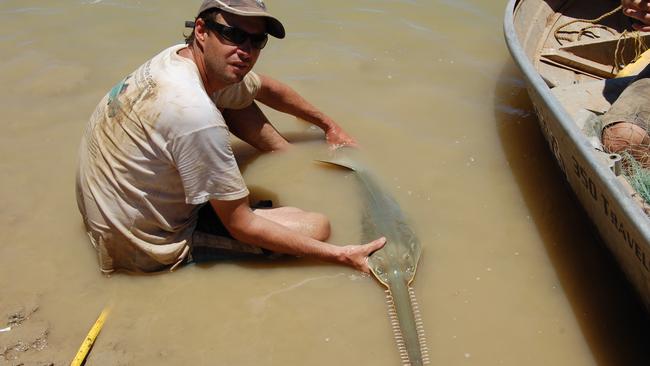Climate more than a sore point for threatened sawfish
In our northern rivers lives a saw-wielding monster that can grow to 6m — but maybe not for long.

In the northern rivers of Australia lives a saw-wielding monster that can grow into an adult 6m long from saw tip to powerful tail.
Sawfish have disappeared from almost every part of the world, often drowning in nets that entangle their tooth-edged rostrum. The species is hanging on in Kimberley wilderness areas like the mighty Fitzroy River, where they bottom-feed on small fish and prawns and pose no harm to humans.
Yet even in this pristine refuge, unpredictable rains and rising temperatures are threatening these gentle prehistoric giants. The Kimberley sawfish is ranked No 1 among evolutionarily distinct and globally endangered animals facing extinction. “They’re in this little outgroup with sharks and rays,” says Murdoch University scientist David Morgan, who has studied them since 2001. “And their relatives, other related sawfish, are in the four top rankings.”
The dire situation is already visible in the drying billabongs along the Fitzroy’s 600km expanse. For the first time in 20 years, says Morgan, there are few sizeable sawfish approaching adulthood to be found in its murky waters.
The problem lies in a run of poor wet seasons from 2012 to 2016 that prevented sawfish pups from making their journey upstream in swollen floodwaters, swimming as far as 200km inland.

If climatic change brings another poor wet season this Christmas, Morgan and US-born research colleague Karissa Lear fear death looms even for those young adults who made it up river in 2017, the most recent flood year, and are maturing. Without a river highway to travel, they may never make it back to the ocean to mate.
Twice yearly, the scientist pair work alongside Nyikina Mangala indigenous rangers in the lower Fitzroy River area to track the number, movements and body temperature of the animals, using acoustic tags that “hear” them moving past riverbank listening posts.
“We’ve been able to link juvenile recruitment with the level of flow in the river,” says Morgan, who is funded by Murdoch’s Harry Butler Institute. “In good wet seasons, we get lots of pups coming into the river and surviving. In poor ones, we see hardly any.”

Lear says sawfish cannot control their body temperature, so any rise in water temperature in fast-evaporating pools affects the animals. “When the temperatures are really high and food is low, they have to use a lot more energy to function. Even a few degrees of rise due to climate change could affect their ability to withstand starvation,’’ says Lear, who studied sawfish in the US before arriving in the Kimberley on a three-year research program.
“People have known some of this for a long time, but we’re starting to see the impact. The last wet season was the worst in 20 years, and there’s very little water in the river.”
This month, a chance encounter with tourists saw two sawfish rescued by Morgan’s team from a pool only 20cm deep and released into deeper waters upstream. If plans to dam more rivers for big-scale agriculture ever eventuate, the sawfish fate may be sealed.
Meanwhile, everyone is hoping for big rains. If not, the sawfish pups that hold the promise of renewal may end their days in stagnant pools along the Fitzroy River.



To join the conversation, please log in. Don't have an account? Register
Join the conversation, you are commenting as Logout